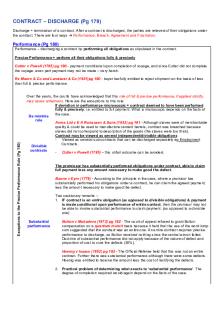Law Case Study 1: Misplaced Affections: Discharge Sexual Harassment PDF

| Title | Law Case Study 1: Misplaced Affections: Discharge Sexual Harassment |
|---|---|
| Author | Danelle Lindo |
| Course | Human Resource Management |
| Institution | Jacksonville State University |
| Pages | 1 |
| File Size | 63.1 KB |
| File Type | |
| Total Downloads | 21 |
| Total Views | 136 |
Summary
Case Study...
Description
Danelle Lindo Case Study 1 - Misplaced Affections: Discharge for Sexual Harassment 9/17/2018 1. Evaluate the conduct of Peter Lewiston against the EEOC’s definition of sexual harassment. Sexual harassment is the unwelcome sexual advances, requests for sexual favors, and other verbal or physical harassment of sexual nature. According to EEOC it can also include offensive remarks about a person’s sex. EEOC recognizes 2 forms of sexual harassment, first being quid pro quo, which is submission to or rejection of sexual conduct used as a basis for employment decisions. The second type is hostile environment, which occurs when unwelcome sexual conduct has the purpose or effect of unreasonably interfering with job performance or creating a hostile work environment. Peter Lewiston created a hostile environment for Beverly Gilbury. There were many occurrences where Gilbury rejected Lewiston but he continued to make sexual advances towards her. He understood she was married but continued to verbally make comments to her that made her uncomfortable as well as sending flowers, leaving notes, and showing up at her car as she’s leaving. Since Lewiston continued to try and be “more then friends” with Gilbury made the work environment intimidating and uncomfortable for her. 2. Should the intent or motive behind Lewiston’s conduct be considered when deciding sexual harassment activities? Explain. Every side to the story should be heard, so Lewiston’s intent or motive should be considered but should not be the deciding factor in the case. Since action was taken so many times towards Gilbury, knowing she is married, she has rejected and clearly stated they can only be friends eliminates Lewiston’s motive. 3. If you were the district’s EEOC officer, what would you conclude? What disciplinary action, if any, would you take? Disciplinary action should be taken against Lewiston, however I do think the extent to which he is being terminated is over the top. There are some things I would take into consideration before deciding on the consequences. First, Lewiston has been working in the PCUSD for 11 years and had not had any sexual harassment issues prior to these events. Another part is that all the acts of sexual harassment occurred within 4 days and she directly went to the EEOC. Maybe if she went to her supervisor with her concerns, the school may have been able to handle the situation and talk to Lewiston and all would have stopped. Lewiston could have been switched schools so it would have not been a hostile environment for Mrs.Gilbury and warning been given, but now he is left without a job. Also, Mrs.Gilbury could have been given some type of money for emotional distress....
Similar Free PDFs

Discharge Summary - Case Study
- 2 Pages

Law - 11 Discharge of contract
- 7 Pages

Law Case Study
- 2 Pages

Harassment Summary
- 1 Pages

CASE LAW - Case Law
- 5 Pages

Study Notes Sexual Offence
- 5 Pages

Case #1 Individual - Case study.
- 3 Pages

Case Law - Case law summaries
- 71 Pages

Case Study 1 Pearson - case
- 4 Pages
Popular Institutions
- Tinajero National High School - Annex
- Politeknik Caltex Riau
- Yokohama City University
- SGT University
- University of Al-Qadisiyah
- Divine Word College of Vigan
- Techniek College Rotterdam
- Universidade de Santiago
- Universiti Teknologi MARA Cawangan Johor Kampus Pasir Gudang
- Poltekkes Kemenkes Yogyakarta
- Baguio City National High School
- Colegio san marcos
- preparatoria uno
- Centro de Bachillerato Tecnológico Industrial y de Servicios No. 107
- Dalian Maritime University
- Quang Trung Secondary School
- Colegio Tecnológico en Informática
- Corporación Regional de Educación Superior
- Grupo CEDVA
- Dar Al Uloom University
- Centro de Estudios Preuniversitarios de la Universidad Nacional de Ingeniería
- 上智大学
- Aakash International School, Nuna Majara
- San Felipe Neri Catholic School
- Kang Chiao International School - New Taipei City
- Misamis Occidental National High School
- Institución Educativa Escuela Normal Juan Ladrilleros
- Kolehiyo ng Pantukan
- Batanes State College
- Instituto Continental
- Sekolah Menengah Kejuruan Kesehatan Kaltara (Tarakan)
- Colegio de La Inmaculada Concepcion - Cebu






